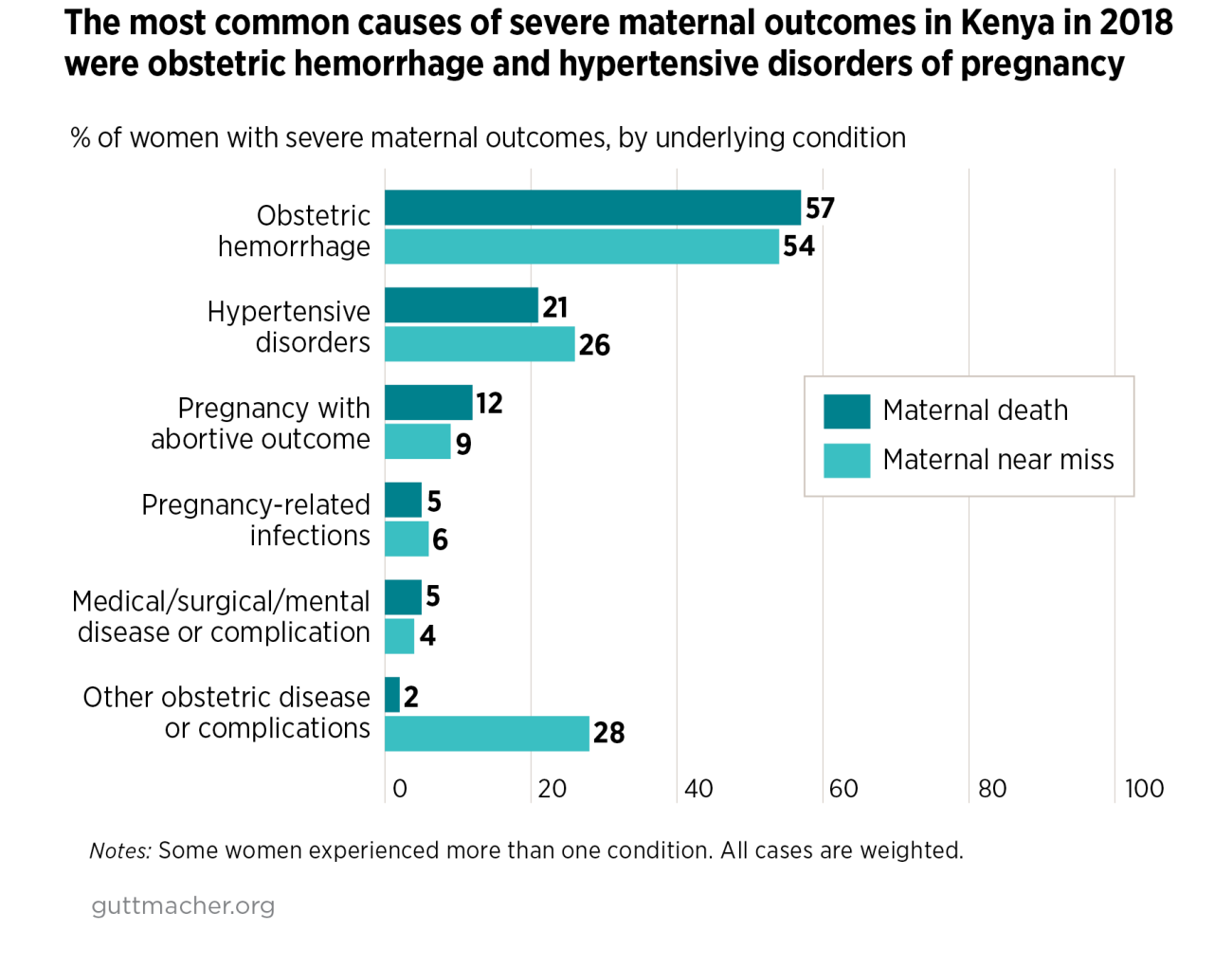Despite efforts by the Kenyan government to invest in maternal health, maternal mortality has not declined significantly over the past 15 years. With the aim of providing policymakers and health care providers the evidence necessary to improve maternal health care, this fact sheet presents new findings on the number of women experiencing a maternal near miss (i.e., those who almost died in pregnancy or soon after childbirth or pregnancy termination), as well as the burden of severe maternal outcomes and the quality of obstetric care in 54 referral hospitals in 27 counties in Kenya in 2018.
Severe Maternal Outcomes and Obstetric Care in Kenya
Key definitions
Maternal near miss: When a woman nearly dies from a complication that occurs during pregnancy or childbirth, or within 42 days of pregnancy termination.
Maternal death: The death of a woman during pregnancy or within 42 days of pregnancy termination from any cause related to or aggravated by the pregnancy or its management that is not from accidental or incidental causes.
Severe maternal outcome: A life-threatening condition (i.e., organ dysfunction) related to pregnancy, labor or abortion; all maternal near-miss cases and maternal deaths fall into this category.
Incidence of maternal near miss and death
- Out of the 36,162 live births that occurred in 2018, there were 360 maternal near misses and 17 maternal deaths. In addition, 318 women experienced potentially life-threatening conditions that were not near-miss events.
- There were 7.2 maternal near misses for every 1,000 live births.
- For every 100,000 live births in Kenyan referral hospitals, there were an estimated 36 maternal deaths.
Characteristics of women treated for maternal near miss and death
- Among women with severe maternal outcomes, 69% were aged 20–34.
- Sixty-six percent of women with maternal near-miss events and 82% of women who died from maternal causes received antenatal care.
- About 20% of women who experienced a maternal near miss also experienced a fetal death.
Primary causes of maternal near misses and deaths
- Obstetric hemorrhage and hypertensive disorders of pregnancy were the most common causes of maternal near miss (54% and 26%, respectively) and maternal death (57% and 21%, respectively).
- Pregnancies with abortive outcomes were the underlying cause of 12% of maternal deaths and 9% of maternal near misses.

Quality of care provided for maternal near misses
- None of the interventions aimed at preventing severe maternal outcomes were provided to all women in the study who needed them.
- The conditions with the highest proportions of women receiving the recommended interventions were obstetric hemorrhage, cesarean sections, and severe infection or sepsis (93%, 98% and 99%, respectively).
- Provision of essential interventions for other obstetric conditions was much lower—for example, 77% of women with severe preeclampsia or eclampsia received magnesium sulphate, 67% with antepartum hemorrhage who required blood received it and 44% of women with a ruptured uterus had surgery within three hours of admission in a hospital.
- Sixty-four percent of women experienced their severe maternal outcome before admission, and the majority of them were referred to the study hospitals from lower-level facilities. About 36% of women who had a near miss began experiencing severe complications during their hospital stay.
Recommendation
The Ministry of Health and hospital management authorities should implement strategies to ensure effective patient triage and the prompt administration of lifesaving care for women who experience life-threatening complications related to pregnancy.
Source
The information in this fact sheet can be found in Owolabi O et al., Incidence of maternal near‑miss in Kenya in 2018: findings from a nationally representative cross‑sectional study in 54 referral hospitals, Scientific Reports, 2020, 10:15181, doi:10.1038/s41598-020-72144-x.
Acknowledgments
This study was made possible by financial support to the Guttmacher Institute by UK Aid from the UK Government and the Dutch Ministry of Foreign Affairs, and to the African Population and Health Research Center through generous support from the William and Flora Hewlett Foundation (grant 2015-3063) as well as the Segal Family Foundation. The findings and conclusions contained in the study are those of the authors and do not necessarily reflect the positions and policies of the donors.
Reproductive rights are under attack. Will you help us fight back with facts?